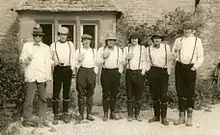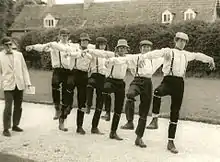The Cloggies
The Cloggies, an Everyday Saga in the Life of Clog Dancing Folk, was a long-running cartoon by Bill Tidy that ran in the satirical magazine Private Eye from 1967 to 1981, and later in The Listener from 1985 to 1986. It gently satirised northern English male culture, and introduced a shocked nation to the scurrilous delights of Lancashire clog-dancing. This particular variation of the art involved two teams dancing towards each other in formation, followed by each attempting to cripple their opponents with gracefully executed knee and foot moves. Thus the Forward Sir Percy, a synchronized low-level knee attack, the Double Arkwright wi' Ankle Lever, the Heckmondwycke with Reverse Spin and the ever controversial Triple Arkwright. Other routines included the Half Arkwright with Groin Action, the Erotic Elbow Drive and the match-winning Flying Arkwright, performed to cries of, “Keep them knees stylish!”

The team
The Cloggies were undisputed champions of their ‘sport’, usually inflicting grave injuries before repairing to the nearest pub. Their capacity for beer was legendary; their home venue, the Clog & Bells, Blagdon, where Doris the barmaid was always in a welcoming mood. There were also unorthodox activities involving the use of ferrets.
The series lampooned current sports culture and introduced an entire sub-culture of dance leagues, a governing body for the sport (characterised as officious, clumsy, bureaucratic, out-of-touch and based on the Football Association), an idiosyncratic cast of sociopaths and a yearning for earlier, gentler days of greater respect (such as the famous Policeman on a White Bicycle). As a reflection of the officious nature of league officials and umpires (who always had it in for the lads) the scoring system was deeply arcane and complex, with final scores such as 124.863 to 9214⁄37 being recorded.
The team consisted of:
- Stan Postlethwaite (captain), later ennobled as Lord Stan of Blagdon
- Albert Postlethwaite (second boot, with his false teeth)
- Neville (third boot; trilby and glasses) (or Wilfrid, trilby, glasses and moustache)
- Arnold (fourth boot)
- Ted (fifth boot, with the grey socks)
- Wally (sixth boot, later deceased, replaced by Norman).
- Norman (bearded).
Other unsavoury local residents included Reginald ('Reg') Thrumper, the "Blagdon Amateur Rapist" and the unnamed 'Blagdon Groper and Nuisance'.
Origin

The sub-title, an Everyday Saga in the Life of Clog Dancing Folk, parodied the subtitle to the long-running BBC radio series, The Archers, which was subtitled an Everyday Story of Country Folk. Three retrospective collections of the cartoons were published between 1969 and 1977, with titles The Cloggies (1969), The Cloggies Dance Again (1973) and The Cloggies Are Back (1977).
Bill Tidy's inspiration for this series may have grown out of one of his cartoons in Punch in the mid 1960s, where he parodied the funding objectives and credibility of the Arts Council of Great Britain by illustrating a group of morris dancers in full costume, gathered around a table outside a pub, behind an enormous pile of empties, with one of them asking "Well lads, what are we going to do wi' rest of Arts Council grant ?"
Final triumph
In one cartoon, the Cloggies were selected to represent Great Britain in the 1966 International Folk Dance Festival, beating the USSR in the final despite Wally’s double hernia, and returned victorious to Blagdon with the Gold Boot of Strichtenstein. They were persuaded to turn professional by their new manager, Morris ‘Zip’ Fassner (later Shufflebottom) and embarked on a world tour before once more returning to the Clog & Bells and rejoining their local league. Their opponents included The Bull & Veterinary Surgeon, The Rat & Goldfish, The Horse & Shovel, The Truss & Slagheap, The Fox & Pervert, The Grunting Duck and Gridley’s Soap Works. In 1966, a strip showed the Cloggies winning the United Kingdom Drunk and Disorderly Shield.
The Cloggies of University Hall, Buckland
Inspiration

Although other dancers have more recently appropriated the name, The Cloggies originally took on a real life of their own in 1968 when a group of students at University Hall, Buckland in Oxfordshire, became so inspired by the cartoon characters’ pub-oriented career that they formed their own squad. Photographs from the period show the team in the following order: Stan (Pete Metcalfe), Wally (Gwyn Ellis), Neville (John Barton), Arnold (Iain Murray), Ted (Andy Carr) and Albert (Al Guyver). The shady-looking character is the manager, Morris (Mike Fernie). Arthur (Nigel Brewis), was later named as reserve boot in case of injury or hangover. Bill Tidy personally wrote to the team to officially endorse and encourage them, delighted that “all those years spent labouring on Spam have produced a debased art form”.
Live performances

The Cloggies performed uninvited and to mixed receptions at several college discos, offering terrifying moves such as The Forward Lunge with Curse, but their big breakthrough came when asked by producer Martin Pennock to take on the country-dancing roles in the closing scenes of John Milton’s Comus . Buckland was the smallest ever college (120 students) to enter the Sunday Times / NUS Drama competition. The preliminary round took place at Lord Faringdon’s private theatre, whose stage was just wide enough to accommodate six Cloggies dancing abreast. As the play was about to start, the lights failed so everyone settled in the pub until the power-cut ended. The adjudicator seemed much more enthusiastic two hours and several pints later, but there was a serious delay in getting the Cloggies from the bar and back on stage. Their performance was hampered by a spread of fruit and milk underfoot from the previous orgy scene and most spectators felt it was a disaster.
Final triumph
Buckland was one of eight chosen from sixty universities and colleges to travel to Southampton University for the Student Drama Festival Finals in the winter of 1970/71. After sitting through several other productions, the audience went wild when the Cloggies hit the stage at the end of Comus. The Southern Arts Review praised the ‘boisterous rustic dancing Cloggies’, while French radio covered the event, describing them as “un groupe de danseurs folkloriques” and playing a recording of them dancing to the strains of Fairport Convention’s Lark in the Morning – the boots, the bells, the yells.[1] Nicholas de Jongh, drama correspondent of The Guardian, wrote that the play was ‘… degraded into a cheap grotesque pantomime’, adding that, ‘the late appearance from the dancing Cloggies underlined the cheapness of the conception.’[2] This was seen by the lads as a complete vindication of all they had stood for.
The team’s swansong was as dancing shepherds in the British premiere of the medieval French fable Aucassin and Nicolette, translated by Alex Kerr and produced by Pennock in the college grounds on 27 June 1971. The use of a full beer crate as a prop did not interfere with the narrative.
References
- English Dance and Song Winter 1973
- The Guardian 4 January 1971